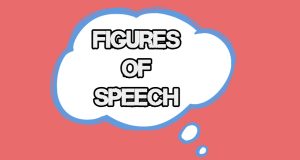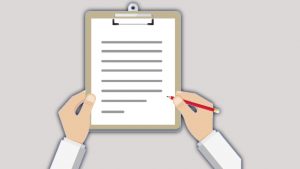Figures of Speech in Literature (With Examples): Literature is a body of written works. This could either be Drama, Poetry, and Prose distinguishable in their various form, structure, style, and use of figurative language. This Figurative language used in these three genres of Literature (Drama, Poetry, and Prose) is what we call Figures of speech.
By way of definition, figures of speech are literary devices which achieves a special effect by using words in a distinctive way. In other words, they are words or a phrase which possesses a separate meaning from its literal definition.

Recommended: Best science courses to study in the university
Major Types of Figures of Speech With Examples
There are a plethora of these Figures of Speech employed in Literature. They are:
1. Alliteration: Alliteration is a figure of speech used where a sentence in a literary work particularly a Poem, consists of a series of word with the same consonant sound at the beginning of such word. In simpler words, Alliteration is the repetition of an initial consonant sound at the beginning of words which are in close proximity with each other.
For example:
Obi buys seashells by the seashore.
The Ship Sailed and Sinked like the Titanic.
Betty Botter bought some butter.
2. Antithesis: Antithesis is a figure of speech which places two contrasting words or ideas side by side in a sentence.
For example:
Many are called, but few are chosen.
To err is human; to forgive is divine
Man proposes, God disposes.

Recommended: Difference Between I Am and Am (With Examples)
3. Apostrophe: Apostrophe is a figure of speech which directly addresses a person who is not present, an animate object or a non-living thing.
For example:
Oh! My God, how wonderful you are.
Alarm clock please don’t fail me tonight.
4. Assonance: This is a figure of speech similar to, but the reversal of Alliteration. That is to say that it is the repetition of Vowel sounds which are in close proximity.
For example:
Ada seems to beam rays of sunshine with her eyes of green
The light of the fire is a great sight.
5. Euphemism: Euphemism is a figure of speech which expresses unpleasant words in a pleasant manner. It can also be said to be the substitution of a cool word into a sentence when referring to something harsh or unpleasant.
For example:
Emeka passed away in his sleep (This is an Euphemism used to describe the unpleasant occurrence of Emeka dying while sleeping)
Faith is visually impaired (This is an Euphemism used in literature to state that Faith is blind)
David appears to be mentally challenged (This is to say that David is stupid and foolish).

Also see: Best commercial courses to study in the university
6. Hyperbole: A Hyperbole is literally an overstatement or exaggeration. It is therefore a figure of speech used to lay emphasis on a thing, heighten the effect of something or show over excitement about a thing.
For example:
The joy on my face was brighter than the sunshine
I have told you a million times to stop talking to me
Samuel kept knocking at my door a thousand times
The fear of losing made me run faster than Usain Bolt.
7. Litotes: Litotes is the direct opposite of Hyperbole. It therefore means an understatement, and is a figure of speech which expresses an affirmative by the negative of its contrary. It therefore makes a situation less serious than it actually is.
For example:
It is not the best weather today (This statement will be a Litotes during a period of heavy rainfall and storm as it is implying through an ironic understatement that the weather is horrible.
He was not unfamiliar with the articles of David (This is an understatement to show that he was knowledgeable about the articles of David)
The price of the phone was not the cheapest (This is a Litotes to illustrate that the price of the phone was quite expensive).
8. Irony: Irony is a figure of speech which expresses the direct opposite of what is intended or the literal meaning. Irony is used to illustrate where there is a contrast between what is said by a person and what is meant, and where contradictory situations reveal a reality from what appears to be true.
For example:
You are as beautiful as gold (This is an Irony when addressing a mad and tattered person)
The police station got robbed yesterday Night (This is an example of situational irony)
Go get a job (This is an Ironic statement when coming from an unemployed person).
Also see: How to be a good conversationalist
9. Paradox: Paradox is a figure of speech employed to express a foolish, absurd or contradictory statement which may be true.
For example:
The Child is the father of the man
Some of the biggest failures I ever had were successes
War is peace.

10. Personification: Personification is used to illustrate a figure of speech wherein the attributes of a living thing or character is given to an inanimate thing. It can also be said to mean where an inanimate object or non-living thing is endowed with human features or abilities.
For example:
My Alarm clock yells loudly at me every morning
The stars winked at Night
The wind kissed me profusely
Upon my return, my dog smiled at me.
Recommended: How to prepare and pass any scholarship examination
11. Simile: Simile is one of the most common figure of speech. It is simply used to compare two dissimilar things which have something in common. In other words, Simile is the comparison of two unlike things using ‘like’ or ‘as’.
For example:
Blessing is as white as snow
Timi loves to eat like a pig
You were as brave as a lion
Juliet swims like a fish
12. Metaphor: Metaphor is a figure of speech which refers to a thing by mentioning another thing. It can therefore be said to mean an implied comparison between two things, stating that one thing is another.
For example:
The girl is a peacock
Laughter is the best medicine
Her melodious voice is music to my soul
Tochukwu is a walking dictionary.
N/B: A Metaphor differs from a Simile, as while Simile is comparing two things by saying that one thing is like another, Metaphor implies a comparison between two things by saying that one thing is another.
Recommended: How to prepare for an interview and pass excellently
13. Oxymoron: Oxymoron is a figure of speech which places two contradicting words or words which have opposite meanings next to each other in a sentence.
For example:
The beating was a sweet agony
His joke was seriously funny
The fresher was clearly confused.
14. Onomatopoeia: Onomatopoeia is a figure of speech which makes use of words to represent sounds through the imitation of that sound by words associated with it.
For example:
Tick Tock says the clock
I was woken by the Crow Crow of the hen
The stone hit the water with a splash
The moans from the room was quite loud.
Recommended: Highest paying professions in the world 2021
15. Metonymy: Metonymy is a figure of speech which substitutes a word for that closely associated with it. That is to say that a name or thing is replaced in a sentence by a word closely related or associated with it.
For example:
The power of the crown was strengthened (Crown here means King)
There have been lots of good policies and projects from the White House (White house refers to the president of the United States).

Edeh Samuel Chukwuemeka, ACMC, is a lawyer and a certified mediator/conciliator in Nigeria. He is also a developer with knowledge in various programming languages. Samuel is determined to leverage his skills in technology, SEO, and legal practice to revolutionize the legal profession worldwide by creating web and mobile applications that simplify legal research. Sam is also passionate about educating and providing valuable information to people.